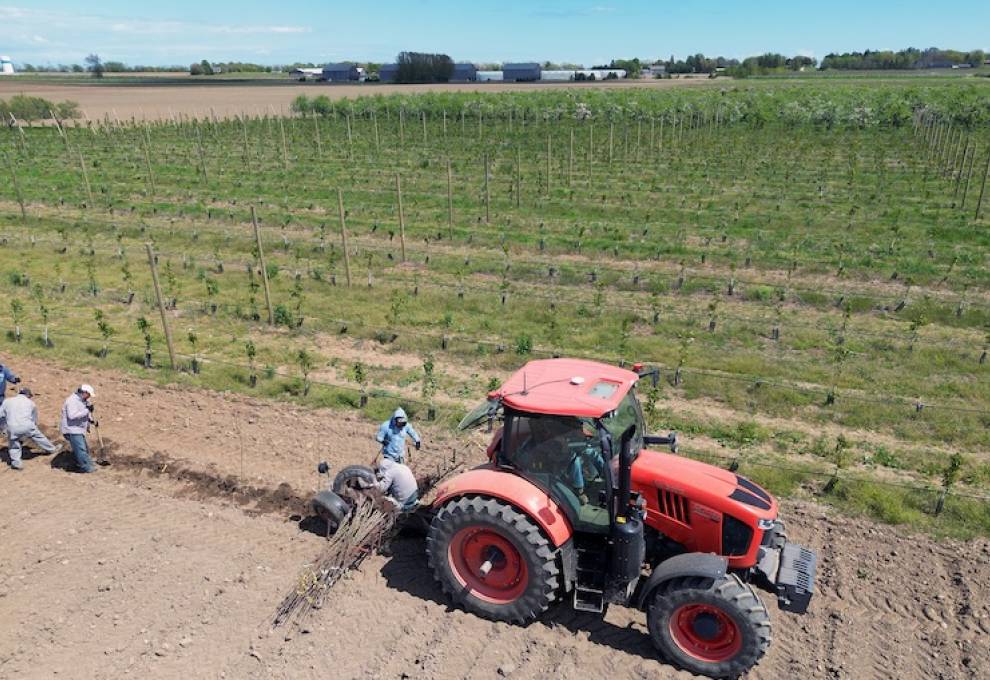
For Rusty Smith, growing pears has been a lifelong endeavor -- 60 years and counting. The 82-year-old tree fruit grower is a legend in Ontario. Part of his legacy will be the Happi pear (HW624).
In spring 2024, he planted three acres of the HW624 pear at Blenheim, Ontario’s Manitree Fruit Farms. This was the fifth year of planting the new cultivar which matures 10 days later than a Bartlett, but with the familiar red-blushed skin.
“I first heard about this pear through Gene Penner at the Canadian Fruit Tree Nursery and Matt Ecker, vice-president of sales at Vineland Growers’ Cooperative,” recalls Smith. “We have some open ground to plant new pears, but the first question was whether there is a market for them. There’s no point in growing them without a market.”
With assurances from Vineland Growers’ Cooperative, Smith proceeded with planting in rows 12 feet apart and five feet between trees on wire support so that lateral limbs can grow at the proper angle. The clay loam soil has proven to grow pears well.
“Harvest was shockingly light this fall,” reports Smith’s son-in-law Brian Rideout. “Mother Nature is a cruel jokester. This year, fruit size was down considerably due to drought and this affected volumes. We have seen yields in the past as high as 30 bins per acre.”
It’s considered to be a mid-season maturing pear. Normally, that would mean a harvest time of early September, but harvest 2025 started in late August.
The trees came from Canadian Fruit Tree Nursery, Jordan Station, Ontario. Gene Penner, a grower for the company, explains that the variety was bred by Agriculture and Agri-food Canada (AAFC) and is managed by Vineland Research and Innovation Centre (Vineland). Vineland has engaged Stemilt Growers LLC (Stemilt) and the Associated International Group of Nurseries (AIGN) who will contribute their expertise to commercializing the Happi pear around the world. Stemilt leads these efforts in North America. The variety’s resistance to fire blight and pear psylla are key characteristics that are attractive to growers.
Long road to commercialization
According to the website of the Canadian Food Inspection Agency, 'HW624' arose from the controlled cross of 'Harrow Sweet' and 'NY10353' made in 1988 by Dr. D. M. Hunter at the AAFC Research Station in Harrow, Ontario. It was selected as a hybrid seedling in 1995 and propagated by budding on pear seedling rootstocks. Trees were planted in an evaluation orchard at the AAFC Research Farm at Jordan Station, Ontario in 1999. This selection was advanced by Dr. Hunter and made available for testing, as 'HW624', in regional trials in cooperation with the Ontario Fruit Testing Association beginning in 2000.
Commercialization is a long, tedious process that is often triggered by a sudden need in the industry. That’s what happened in the early 2000s with the collapse of the pear canning industry in southern Ontario. As Matt Ecker recalls, “A lot of growers pulled out their pear trees at that time. But then there was incentive to find a fresh-market pear that would store well and extend the local season throughout the winter.”
Ecker continues, “Its unique shape and ability to develop a red cheek will make it really attractive on shelf and once you bite into it, the flavour is very sweet with a zesty bite. Something I know customers will come back for.”
As the timeline inched forward, AAFC contracted Vineland in 2013 to manage evaluation and commercialization of its tree fruit portfolio.
“This variety transitioned from the on-farm selection process to our consumer branding and marketplace testing analysis and was quickly identified as a desirable pear choice by consumers and growers,” says Dr. Ian Potter, president and CEO at Vineland. “Finding the right collaborator was the next step in the commercialization pathway to bring HW624 from our farm to consumer tables.”
As the global production and marketing manager, Stemilt Growers, a Washington State-based company, will also lead the release of the variety in Canada. They are owned and operated by the Mathison family, a well-known grower, packer and shipper of tree fruit.
“We’re excited to be part of innovation in the pear category with the fantastic HW624 cultivar,” says West Mathison, president at Stemilt. “The Vineland team selected a pear with characteristics that make it grower and consumer-friendly so this will be a great benefit to Canadian growers. It has the qualities that will delight existing and new pear shoppers throughout the country.”
“Ontario-grown pears will never be available 12 months of the year like apples,” says Ecker. “But working with the right variety and the right storage makes for a stable industry.”
In anticipation of many acres of the Happi pear to be grown in Ontario, the Vineland Growers’ Cooperative is doubling the size of its controlled atmosphere storage capacity in Virgil. Shovels should be in the ground as of November, 2025.
As Rusty Smith and other tree fruit growers can attest, commercialization is not a linear process.

